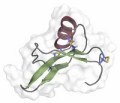
‘Be as creative, obscure and tangential as possible,’ is Allan Jordan’s advice to anyone surfing the net for a new job. He tried every site available until he got his present position at Cambridge-based Ribotargets a small pharmaceutical research outfit, having worked on novel pro-drug approaches to the treatment of malignant melanoma (MDEPT) and other anticancer agents at Reading University in England.
Jordan’s method worked well. ‘I searched every job site for any vacancies not just in medicinal chemistry, but in assay development, molecular biology, biochemistry, and pharmacokinetics,’ he says and this eventually got him a job.
When you are looking for that perfect position, a spot of surfing could certainly speed things up. Some approaches might work better than others and in the end it all boils down to what you have to offer and what you are looking for.
A general jobs site such as New Scientist Jobs or ScienceCareers is probably as good a place to start as any. ‘The best use I’ve found of the net is the on-line newspapers, The Guardian, The Telegraph, New Scientist…’ says Bob Noble, virtual reality researcher at the Robert Gordon University, Aberdeen. Nature, New Scientist and Science took the brunt of Jordan’s searching too, but there’s lots of competition from other applicants from the print editions, which is where a more focused site like ScienceCareers or ScienceJobs can help.
ScienceCareers provides more than just jobs listings adding advice, employer profiles, careers fair information and features on job-market issues. ‘Such sites also helps you prepare for an interview,’ says biology post-doc Sarah Milburn.
If your ambitions are more focused, then a specialist site might be the next place to visit. ‘If you go to the more generalized sites,’ Paul Guinnessy, Webmaster at PhysicsWeb explains, ‘you get swamped by adverts, with a specialist site you can drill down to specific subject areas.’
In contrast, Noble found the experience of net job searching disheartening, ‘Basically, my difficulty is matching what I have to what is there. Years of research and development experience, a PhD in computer graphics, a maths degree, experience with robots and the nuclear industry. I’m a researcher more than a programmer, I like graphics but I don’t write games. How do you tell that to a search engine?’
There are more useful approaches for specialist job seekers, however. ‘The general rule,’ says Darien Pugh who headed up ChemWeb’s Job Exchange [no longer available], ‘is the more specific a site, the more likely you are to look at it and the more likely you are to come across the information you need.’ Paul Heelis of Chemjobs.net emphasizes the point, try searching for a chemistry job at a general site, he suggests: ‘You will be lucky to get more than three,’ he says.
Stephanie van Willigenburg highlights the international benefits of job seeking on the net if you’re working abroad. ‘I’m doing a post-doc at York U in Toronto, and certainly all the jobs I’ve applied for this year have been from internet lists or the Web,’ she says, ‘the web has been invaluable for reading ads in the UK’s Times Higher Education Supplement and useful for checking out people’s research interests so you can tailor your application to a particular department.’
According to Phil Mackie who did endless surfing till he got his current post-doc position at Trinity College Dublin, ‘The web sites of the learned societies and the science journals are the best place to start because the other sites don’t focus on the scientific sub-divisions.’ As far as uploading a resume though, he says, ‘Sometimes you need to ‘fine tune’ a resume to match the job you are going for – but if you’re posting your resume it has to be general.’
Chris Rayner a researcher working on nucleic acids and biotransformations at Leeds University has successfully placed ads for post-docs on the academic site www.jobs.ac.uk. But, while that has been a successful approach for finding candidates, he reveals that his own students are more likely to get a job through careers fairs than by other means, though.
Some web sites allow you to post a resume into a repository of putative interviewees. What approach might you use to boost the chances of your resume being picked from the potentially hundreds if not thousands of others out there? ‘It is crucial to put in all the important information,’ says Pugh, ‘and the kinds of ‘keywords’ you would normally include in a paper resume, such as “teamworker”, “management experience” etc.’
So, your resume is in good shape, is there anything else to watch out for in using the internet as a career stepping stone? First, you should avoid being caught by your employer’s site-tracking software by doing your searching from home – some employers are taking an increasingly hard line on Internet ‘abuse’. But, even if you do all your surfing from home that won’t hide your resume once it is posted so your employer could readily discover you are looking for a new job. ‘Candidates, can specify the companies they don’t want to be shown to at ChemJobs.net’, says Heelis, which offers some protection to the rightly paranoid. Pugh, is also now considering anonymous resume posting for those who want it, although he points out that it is difficult to hide itchy feet in the workplace!
Guinnessy does not recognize this as a problem, in physics at least, and probably the academic world in general. ‘I think most employers are too busy to go surfing around the jobs-wanted pages of various sites and the risk is limited, especially considering most scientists are on short-term contracts anyway!’
This feature article originally appeared in my Adapt or Die column on HMSBeagle although many of the ideas discussed are as valid today as they ever were. However, some of the people interviewed are not necessarily in the same jobs now as they were at the time of writing. Please let me know in the comments if you have any updates I should publish.
ADDITIONAL RESOURCES
AAAS Science Careers
New Scientist Jobs
Institute of Physics Job Site
Science Jobs
Chemistry Jobs
If you have any jobs sites you’d like me to add to the list, please leave a comment and a link




